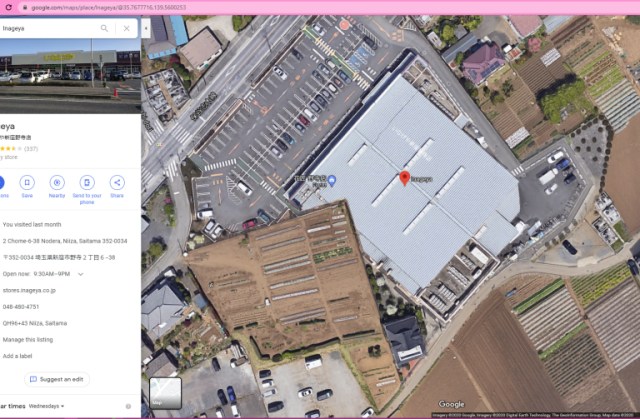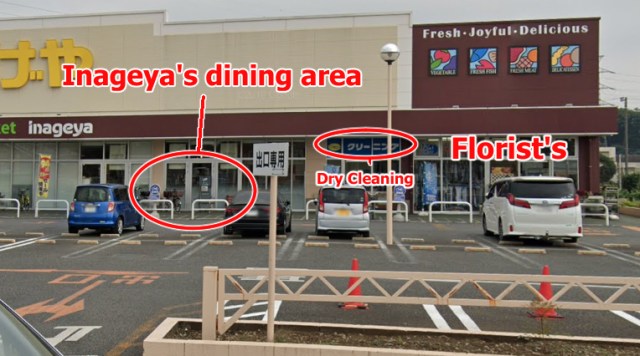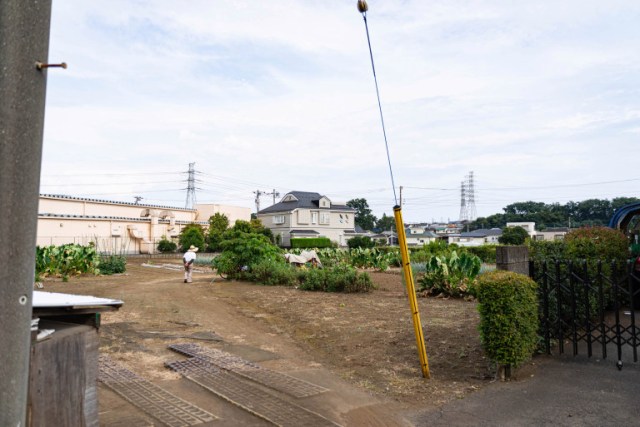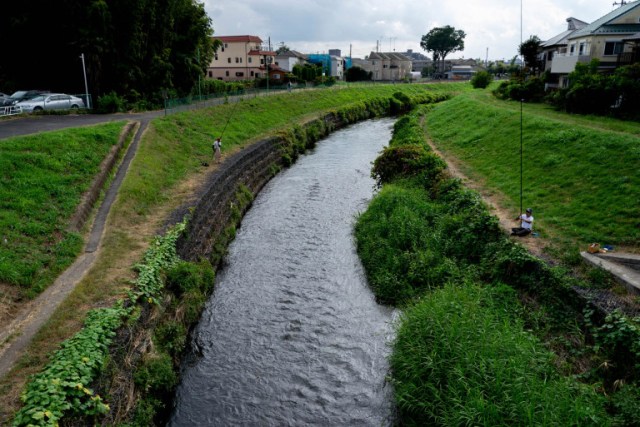
Rumors are flying around the web that the weird layout is due to land disputes or financial drama, but we went to Saitama to get the real scoop.
Climb high enough into the sky and you can see the world from a brand new perspective. It’s easier than ever to glimpse that bird’s-eye perspective, thanks to Google’s ever-updating Google Earth, Google Maps, and Google Street View projects, and therefore much easier to see some peculiar choices in land development. One such case has cropped up a few times this year — a supermarket in Saitama, Japan, which seems to have had a nasty collision with a nearby field.
▼ From above it looks like the field is cutting a chunk out of the supermarket.
Most surprisingly, even people who allegedly used the supermarket, Inageya Niiza Nodera, were surprised to see how bizarre its construction was from above. How could someone who’s used the supermarket, shopped inside its very walls, not be aware of the awkward slice cut out of the supermarket’s side? And how come it had been built like that, anyway? Why was Inageya built so close to farmland? Had they perhaps kicked out some kindly old farmer to secure the land?!
We sent our Japanese-language reporter Tasuku Egawa off to go see what was up. Of course, he immediately went inside the supermarket to see how weird it felt from the inside.
▼ Not very weird at all, as it turns out.
https://www.instagram.com/p/CFv79uwp7Km/?utm_source=ig_embed
Space here is arranged quite neatly. A dry cleaners’ and a florist shop are packed into the tiny little trapezoid of space next to where the field intercepts the Inageya supermarket, and both are separated from the main supermarket building by a wall.
Next to those shops, inside the Inageya proper, is where the supermarket’s dine-in area is situated. Tasuku assumes the long strip that runs alongside the field is the spot in the video that’s filled with vending machines, drinking fountains, and ATMs. It is actually much smaller than the satellite shot leads you to believe.
So there’s one mystery solved. It turns out that a cunning supermarket architect can easily work around the logistics of a field that happens to exist in the middle of it, and an average customer will never even notice. But why was that even necessary in the first place? Could it be that there was some sort of ancient curse on the land, forbidding the field from falling into the encroaching claws of capitalism? Or maybe some stingy landowner cut up the rights to the land like this as a funny prank?
According to the Japan Food Journal, this branch of Inageya opened over 15 years ago. It was unlikely that whoever oversaw the land-selling process was still around, and even if they were and remembered all the details, Tasuku doubted they’d spill everything to a nosy reporter like himself.
Right as he was losing hope, he caught sight of a worker in the field.
Apparently, the elderly gentleman in the field was its current owner! What luck! Tasuku questioned him about the weird relationship between his field and the Inageya beside it, silently praying that he wouldn’t accidentally offend him with his aggressive line of questioning. Thankfully, the field’s owner was eager to help.
First, he put paid to any talks about originally owning the land purchased by Inageya’s developers. The land was originally owned by a neighboring rice farmer. In time, the area upstream of the nearby Kurome River was developed as a housing complex and the quality of the river’s water began to deteriorate to unsafe levels. Just coming into contact with the water could cause inflammation, something our source claimed to have experienced himself. Since the rice field used river water, its crop was impacted as well.
▼ Kurome River in all its glory.
The old man’s memory was quite hazy, but his description of the layout seems to place it somewhere in the Showa era (1926-1989). His claim about the river water being dangerous is corroborated by water quality surveys from Saitama Prefecture’s official website. Around this time, even more houses were built nearby and the rice farmer sold the plot of land to be turned into a tennis court.
The second the tennis court came down, Inageya went up…and there it stands, to this day.
No curses, no bad blood, no sad old man being kicked out due to money-grubbing supermarket developers. While this story might not have the glitz and glamor of the rumors flitting around on social media, there’s a kind of quaint beauty to it. Why not go hunt out some ways your own hometown has changed over the years? As we already know, scouting out spots on Google Maps is a great starting point.
Related: Japan Food Journal, Saitama Prefecture “Some Characteristics of Water Pollution in Urban Rivers”
Photographs © SoraNews24
Screenshots: Google Maps
● Want to hear about SoraNews24’s latest articles as soon as they’re published? Follow us on Facebook and Twitter
[ Read in Japanese ]





 Mystery “nail house” discovered in Japan
Mystery “nail house” discovered in Japan Pizza Hut Japan’s hot lucky bags are perfect for a New Year’s pizza party
Pizza Hut Japan’s hot lucky bags are perfect for a New Year’s pizza party Hayao Miyazaki says Happy New Year to Studio Ghibli fans with new art for Year of the Horse
Hayao Miyazaki says Happy New Year to Studio Ghibli fans with new art for Year of the Horse Studio Ghibli displays The Boy and the Heron Academy Award Oscar in Japan for a limited time
Studio Ghibli displays The Boy and the Heron Academy Award Oscar in Japan for a limited time Japanese park’s English dog turd warning minces no words【Why does Engrish happen?】
Japanese park’s English dog turd warning minces no words【Why does Engrish happen?】 This ad for Ueno Clinic makes no sense… until you realize what the clinic specializes in【Video】
This ad for Ueno Clinic makes no sense… until you realize what the clinic specializes in【Video】 Instant bear curry from the northeastern mountains of Japan【Taste test】
Instant bear curry from the northeastern mountains of Japan【Taste test】 How to get a job in anime with Studio Ghibli director Hayao Miyazaki
How to get a job in anime with Studio Ghibli director Hayao Miyazaki Studio Ghibli unveils new goods that tip the hat to The Cat Returns
Studio Ghibli unveils new goods that tip the hat to The Cat Returns Dragon Quest Burgers and Slime drinks are coming to McDonald’s Japan【Video】
Dragon Quest Burgers and Slime drinks are coming to McDonald’s Japan【Video】 Gacha capsule toy machine sells Casio watch rings in Japan, and we try to get all of them
Gacha capsule toy machine sells Casio watch rings in Japan, and we try to get all of them Starbucks Japan ready to get Year of the Horse started with adorable drinkware and plushies【Pics】
Starbucks Japan ready to get Year of the Horse started with adorable drinkware and plushies【Pics】 7-Eleven Japan’s ramen-cooking robot whipped us up a bowl of noodles【Taste test】
7-Eleven Japan’s ramen-cooking robot whipped us up a bowl of noodles【Taste test】 Cyberpunk anime meets traditional culture in Ghost in the Shell gold leaf Japanese changing screens
Cyberpunk anime meets traditional culture in Ghost in the Shell gold leaf Japanese changing screens 7 great places to see Mt. Fuji from without having to climb it
7 great places to see Mt. Fuji from without having to climb it Hello Kitty Choco Egg figures are an adorable trip through three periods of Japanese pop culture【Pics】
Hello Kitty Choco Egg figures are an adorable trip through three periods of Japanese pop culture【Pics】 Japan’s otoshidama tradition of giving kids money at New Year’s gets a social welfare upgrade
Japan’s otoshidama tradition of giving kids money at New Year’s gets a social welfare upgrade We found possibly the quietest Japanese-style hotel in Tokyo’s bustling Shinjuku district
We found possibly the quietest Japanese-style hotel in Tokyo’s bustling Shinjuku district Lacquerware supplier to emperor of Japan and Pokémon team up for new tableware
Lacquerware supplier to emperor of Japan and Pokémon team up for new tableware Sumo Sanrio! Hello Kitty and pals team up with Japan Sumo Association for new merch【Pics】
Sumo Sanrio! Hello Kitty and pals team up with Japan Sumo Association for new merch【Pics】 Can a dirty butthole make you filthy rich in Japan? We’re starting a New Year’s lottery experiment
Can a dirty butthole make you filthy rich in Japan? We’re starting a New Year’s lottery experiment 7-Eleven Japan starts new temporary luggage storage service in over 300 branches
7-Eleven Japan starts new temporary luggage storage service in over 300 branches Disillusionment at Tsukiji’s tourist-target prices led us to a great ramen restaurant in Tokyo
Disillusionment at Tsukiji’s tourist-target prices led us to a great ramen restaurant in Tokyo Starbucks teams up with 166-year-old Kyoto doll maker for Year of the Horse decorations【Photos】
Starbucks teams up with 166-year-old Kyoto doll maker for Year of the Horse decorations【Photos】 Tokyo considering law requiring more trash cans following litter increase in heavily touristed area
Tokyo considering law requiring more trash cans following litter increase in heavily touristed area Tokyo’s Tsukiji sushi neighborhood asks tour groups to stay away for the rest of the month
Tokyo’s Tsukiji sushi neighborhood asks tour groups to stay away for the rest of the month Nintendo’s Kirby now delivering orders at Kura Sushi restaurants, but not in Japan
Nintendo’s Kirby now delivering orders at Kura Sushi restaurants, but not in Japan Tokyo event lets you travel back in time, for free, to celebrate 100 years since Showa era start
Tokyo event lets you travel back in time, for free, to celebrate 100 years since Showa era start Sanrio theme park in Japan announces plans to expand into a Sanrio resort
Sanrio theme park in Japan announces plans to expand into a Sanrio resort Japan may add Japanese language proficiency, lifestyle classes to permanent foreign resident requirements
Japan may add Japanese language proficiency, lifestyle classes to permanent foreign resident requirements Survey asks foreign tourists what bothered them in Japan, more than half gave same answer
Survey asks foreign tourists what bothered them in Japan, more than half gave same answer Japan’s human washing machines will go on sale to general public, demos to be held in Tokyo
Japan’s human washing machines will go on sale to general public, demos to be held in Tokyo Japan’s deadliest food claims more victims, but why do people keep eating it for New Year’s?
Japan’s deadliest food claims more victims, but why do people keep eating it for New Year’s? We deeply regret going into this tunnel on our walk in the mountains of Japan
We deeply regret going into this tunnel on our walk in the mountains of Japan Studio Ghibli releases Kodama forest spirits from Princess Mononoke to light up your home
Studio Ghibli releases Kodama forest spirits from Princess Mononoke to light up your home Major Japanese hotel chain says reservations via overseas booking sites may not be valid
Major Japanese hotel chain says reservations via overseas booking sites may not be valid Put sesame oil in your coffee? Japanese maker says it’s the best way to start your day【Taste test】
Put sesame oil in your coffee? Japanese maker says it’s the best way to start your day【Taste test】 No more using real katana for tourism activities, Japan’s National Police Agency says
No more using real katana for tourism activities, Japan’s National Police Agency says Starbucks Japan reveals new sakura drinkware collection, inspired by evening cherry blossoms
Starbucks Japan reveals new sakura drinkware collection, inspired by evening cherry blossoms Updated cherry blossom forecast shows extra-long sakura season for Japan this year
Updated cherry blossom forecast shows extra-long sakura season for Japan this year
Leave a Reply